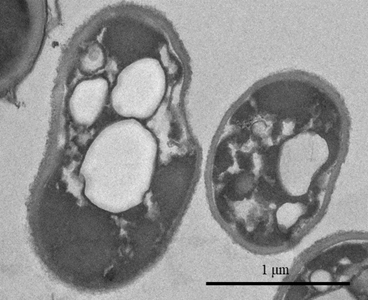Inexpensive Production of Poly (3‑hydroxybutyrate‑co‑ 3‑hydroxyvalerate) from Bacillus megaterium PP-10 Using Pineapple Peel Waste
Main Article Content
Abstract
Pineapple peel waste has recently been interested in being utilized as a low-cost carbon source in PHA biosynthesis to reduce the production cost of PHA. The production of copolymer Poly(3-hydroxybutyrate-co-3-hydroxyvalerate) [PHBV] by the new Bacillus megaterium PP-10 was investigated. The bacteria were grown in a mixture of pineapple peel hydrolysate (PPH) and 3-hydroxyvalerate (3HV) precursor such as sodium propionate or sodium valerate at ratios of 1:1. Remarkably, the microbial growth and PHBV production in a mixture of PPH and sodium valerate exhibited higher biomass and higher PHA amount than that of sodium propionate, accounted about 2.40 ± 0.07 g/L of DCW and 0.71 ± 0.03 g/L of PHA concentration (PHA content of 29.6%DCW). Moreover, to control the 3HV molar fraction in PHBV, various sodium valerate concentration from 2 to 18 g/L was supplemented with PPH, and the result showed that the 3HV fraction increased linear trend with an increase in valerate concentration and was in the range between 6-35 mol%HV. In contrast, a maximum PHA concentration of 1.65 ± 0.04 g/L content (about 49%DCW) was obtained when B. megaterium PP-10 was cultivated in 18 g/L of total reducing sugar in PPH with 2 g/L of sodium valerate at 12 h of cultivation. Finally, the produced PHBV containing 20 mol%HV was further determined by some thermal properties and found that it possessed the melting and glass transition temperatures of 148°C and -10°C, respectively. Therefore, PHBV synthesized by B. megaterium PP-10 with various 3HV fractions was an excellent choice for biopolymer production.
Article Details

This work is licensed under a Creative Commons Attribution-NonCommercial-NoDerivatives 4.0 International License.
References
Policastro, G.; Panico, A.; Fabbricino, M. Improving biological production of poly (3-hydroxybutyrate-co-3-hydroxyvalerate) (PHBV) copolymer: a critical review. Reviews in Environmental Science and Bio/Technology, 2021, 20, 479-513.
Sharma, V.; Sehgal, R.; Gupta, R. Polyhydroxyalkanoate (PHA): Properties and modifications. Polymer 2021, 212, 123161.
Rivera-Briso, AL.; Serrano-Aroca, Á. Poly (3-Hydroxybutyrate-co-3-Hydroxyvalerate): Enhancement strategies for advanced applications. Polymers, 2018, 10(7), 732.
Chen, Q.; Wang, Q.; Wei, G.; Liang, Q.; Qi, Q. Production in Escherichia coli of poly (3-hydroxybutyrate-co-3-hydroxyvalerate) with differing monomer compositions from unrelated carbon sources. Applied and environmental microbiology, 2011, 77(14), 4886-4893.
Loo, C-Y.; Sudesh, K. Biosynthesis and native granule characteristics of poly (3-hydroxybutyrate-co-3-hydroxyvalerate) in Delftia acidovorans. International journal of biological macromolecules, 2007, 40(5), 466-471.
Sudesh, K.; Abe, H.; Doi, Y. Synthesis, structure and properties of polyhydroxyalkanoates: biological polyesters. Progress in polymer science 2000, 25(10), 1503-1555.
Suhazsini, P.; Keshav, R.; Narayanan, S.; Chaudhuri, A.; Radha, P. A study on the synthesis of poly (3-hydroxybutyrate-co-3-hydroxyvalerate) by Bacillus megaterium utilizing cheese whey permeate. Journal of Polymers and the Environment, 2020, 28, 1390-1405.
Balakrishna Pillai, A.; Jaya Kumar, A.; Kumarapillai, H. Biosynthesis of poly (3-hydroxybutyrate-co-3-hydroxyvalerate) (PHBV) in Bacillus aryabhattai and cytotoxicity evaluation of PHBV/poly (ethylene glycol) blends. Biotech, 2020, 10, 1-10.
Tan, G-YA.; Chen, C-L.; Li, L.; Ge, L.; Wang, L.; Razaad, IMN.; Li, Y.; Zhao, L.; Mo, Y.; Wang J-Y.: Start a research on biopolymer polyhydroxyalkanoate (PHA): a review. Polymers, 2014, 6(3), 706-754.
Bhubalan, K.; Lee, W-H.; Loo, C-Y.; Yamamoto, T.; Tsuge, T.; Doi, Y.; Sudesh, K. Controlled biosynthesis and characterization of poly (3-hydroxybutyrate-co-3-hydroxyvalerate-co-3-hydroxyhexanoate) from mixtures of palm kernel oil and 3HV-precursors. Polymer Degradation and Stability, 2008, 93(1), 17-23.
Du, C.; Sabirova, J.; Soetaert, W.; Ki Carol Lin, S.: Polyhydroxyalkanoates production from low-cost sustainable raw materials. Current Chemical Biology, 2012, 6(1), 14-25.
Hemung, B-O.; Sompholkrang, M.; Wongchai, A.; Chanshotikul, N.; Ueasin, N. A study of the potential of by-products from pineapple processing in Thailand.
Aili Hamzah, AF.; Hamzah, MH.; Che Man, H.; Jamali, NS.; Siajam, SI.; Ismail, MH. Recent updates on the conversion of pineapple waste (Ananas comosus) to value-added products, future perspectives and challenges. Agronomy, 2021, 11(11), 2221.
Sukruansuwan, V.; Napathorn, SC. Use of agro-industrial residue from the canned pineapple industry for polyhydroxybutyrate production by Cupriavidus necator strain A-04. Biotechnology for biofuels, 2018, 11(1), 1-15.
Boonwong, T.; Karnnasuta, S.; Srinorakutara, T. Agricultural wastes potential (pineapple crown, durian peel and sugarcane leaves) on reducing sugar production by using sulfuric acid pretreatment following enzymatic hydrolysis. Asia-Pacific Journal of Science and Technology, 2014, 19(3), 361-370.
Suwannasing, W.; Imai, T.; Kaewkannetra, P. Potential utilization of pineapple waste streams for polyhydroxyalkanoates (PHAs) production via batch fermentation. Journal of Water and Environment Technology, 2015, 13(5), 335-347.
Miller, GL. Use of dinitrosalicylic acid reagent for determination of reducing sugar. Analytical chemistry 1959, 31(3), 426-428.
Kulpreecha, S.; Boonruangthavorn, A.; Meksiriporn, B.; Thongchul, N. Inexpensive fed-batch cultivation for high poly (3-hydroxybutyrate) production by a new isolate of Bacillus megaterium. Journal of bioscience and bioengineering, 2009, 107(3), 240-245.
Comeau, Y.; Hall, KJ.; Oldham, WK. Determination of poly-β-hydroxybutyrate and poly-β-hydroxyvalerate in activated sludge by gas-liquid chromatography. Applied and Environmental Microbiology, 1988, 54(9), 2325-2327.
Tian, J.; Sinskey, AJ.; Stubbe, J. Kinetic studies of polyhydroxybutyrate granule formation in Wautersia eutropha H16 by transmission electron microscopy. Journal of bacteriology, 2005, 187(11), 3814-3824.
Wong, Y-M.; Brigham, CJ.; Rha, C.; Sinskey, AJ.; Sudesh, K. Biosynthesis and characterization of polyhydroxyalkanoate containing high 3-hydroxyhexanoate monomer fraction from crude palm kernel oil by recombinant Cupriavidus necator. Bioresource Technology, 2012, 121, 320-327.
Kim, TK. T test as a parametric statistic. Korean journal of anesthesiology, 2015, 68(6), 540-546.
Masood, F.; Hasan, F.; Ahmed, S.; Hameed, A. Biosynthesis and characterization of poly (3-hydroxybutyrate-co-3-hydroxyvalerate) from Bacillus cereus FA11 isolated from TNT-contaminated soil. Annals of microbiology, 2012, 62(4), 1377-1384.
Wagle, AR.; Dixit, YM.; Vakil, BV. Scale up studies for polyhydroxyalkanoate production by a Bacillus flexus strain with industrial potential. Indian journal of microbiology, 2019, 59(3), 383-386.


